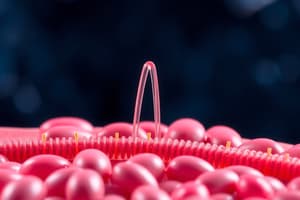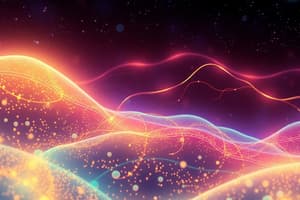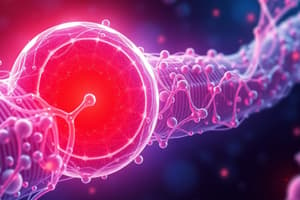Podcast
Questions and Answers
The movement of the RMP can be described as follows: ______ is the movement of the potential from the RMP to a less negative value.
The movement of the RMP can be described as follows: ______ is the movement of the potential from the RMP to a less negative value.
Depolarization
The movement of the ______ can be described as follows: Depolarization is the movement of the potential from the RMP to a less negative value.
The movement of the ______ can be described as follows: Depolarization is the movement of the potential from the RMP to a less negative value.
RMP
Depolarization is the movement of the potential from the ______ to a less negative value.
Depolarization is the movement of the potential from the ______ to a less negative value.
RMP
Depolarization is the movement of the potential from the RMP to a ______ negative value.
Depolarization is the movement of the potential from the RMP to a ______ negative value.
Depolarization is the movement of the potential from the RMP to a less ______ value.
Depolarization is the movement of the potential from the RMP to a less ______ value.
Any change in the membrane potential due to a stimulus is known as a ______ potential.
Any change in the membrane potential due to a stimulus is known as a ______ potential.
A graded potential can be either a depolarization or a ______.
A graded potential can be either a depolarization or a ______.
A ______ is a change in membrane potential that makes the inside of the cell more positive.
A ______ is a change in membrane potential that makes the inside of the cell more positive.
A ______ potential is a type of electrical signal that can travel along a neuron.
A ______ potential is a type of electrical signal that can travel along a neuron.
The size of a graded potential is ______ to the strength of the stimulus.
The size of a graded potential is ______ to the strength of the stimulus.
Glycinergic neurons bind to ______ receptors on postsynaptic cells.
Glycinergic neurons bind to ______ receptors on postsynaptic cells.
These receptors allow ______ to enter postsynaptic cells.
These receptors allow ______ to enter postsynaptic cells.
Glycinergic neurons are essential for maintaining a balance of excitatory and ______ activity in the spinal cord.
Glycinergic neurons are essential for maintaining a balance of excitatory and ______ activity in the spinal cord.
Glycinergic neurons are found in the spinal cord integrating centers that regulate ______ muscle contraction.
Glycinergic neurons are found in the spinal cord integrating centers that regulate ______ muscle contraction.
Glycine is a(n) ______ neurotransmitter.
Glycine is a(n) ______ neurotransmitter.
ON bipolar cells have ______ glutamate receptors.
ON bipolar cells have ______ glutamate receptors.
OFF bipolar cells express ______ glutamate receptors.
OFF bipolar cells express ______ glutamate receptors.
Glutamate receptors on ON bipolar cells are ______.
Glutamate receptors on ON bipolar cells are ______.
The difference in glutamate receptor types between ON and OFF bipolar cells contributes to different ______ responses.
The difference in glutamate receptor types between ON and OFF bipolar cells contributes to different ______ responses.
The ______ is a small mass of tissue that includes the pineal gland.
The ______ is a small mass of tissue that includes the pineal gland.
The pineal gland, located in the ______, plays a role in regulating biological rhythms.
The pineal gland, located in the ______, plays a role in regulating biological rhythms.
The ______ gland is responsible for regulating biological rhythms.
The ______ gland is responsible for regulating biological rhythms.
The pineal gland is involved in the ______ of biological rhythms.
The pineal gland is involved in the ______ of biological rhythms.
Biological rhythms are regulated by the ______ gland.
Biological rhythms are regulated by the ______ gland.
L cones respond optimally at ______ wavelengths.
L cones respond optimally at ______ wavelengths.
M cones respond at ______ wavelengths.
M cones respond at ______ wavelengths.
S cones are best stimulated at ______ wavelengths.
S cones are best stimulated at ______ wavelengths.
Color blindness results from a ______ mutation in the genes that encode the cone pigments.
Color blindness results from a ______ mutation in the genes that encode the cone pigments.
There are three types of ______ that respond to different wavelengths of light.
There are three types of ______ that respond to different wavelengths of light.
Flashcards
Resting Membrane Potential (RMP)
Resting Membrane Potential (RMP)
The electric potential difference across the cell membrane when the cell is at rest.
Depolarization
Depolarization
The process where the membrane potential becomes less negative than the RMP.
Membrane Potential
Membrane Potential
The voltage difference across a cell's membrane due to ion distribution.
Electric Potential Difference
Electric Potential Difference
Signup and view all the flashcards
Ionic Distribution
Ionic Distribution
Signup and view all the flashcards
Action Potentials
Action Potentials
Signup and view all the flashcards
Graded Potential
Graded Potential
Signup and view all the flashcards
Hyperpolarization
Hyperpolarization
Signup and view all the flashcards
Stimulus
Stimulus
Signup and view all the flashcards
L cones
L cones
Signup and view all the flashcards
M cones
M cones
Signup and view all the flashcards
S cones
S cones
Signup and view all the flashcards
Color blindness
Color blindness
Signup and view all the flashcards
Cone pigments
Cone pigments
Signup and view all the flashcards
Glycinergic neurons
Glycinergic neurons
Signup and view all the flashcards
Ionotropic receptors
Ionotropic receptors
Signup and view all the flashcards
Cl- ion entry
Cl- ion entry
Signup and view all the flashcards
Excitatory vs Inhibitory balance
Excitatory vs Inhibitory balance
Signup and view all the flashcards
Spinal cord integrating centers
Spinal cord integrating centers
Signup and view all the flashcards
ON Bipolar Cells
ON Bipolar Cells
Signup and view all the flashcards
OFF Bipolar Cells
OFF Bipolar Cells
Signup and view all the flashcards
Metabotropic Receptors
Metabotropic Receptors
Signup and view all the flashcards
Glutamate
Glutamate
Signup and view all the flashcards
Epithalamus
Epithalamus
Signup and view all the flashcards
Pineal Gland
Pineal Gland
Signup and view all the flashcards
Biological Rhythms
Biological Rhythms
Signup and view all the flashcards
Role of Epithalamus
Role of Epithalamus
Signup and view all the flashcards
Melatonin
Melatonin
Signup and view all the flashcards
Study Notes
Membrane Potentials
- Different cells have different resting membrane potentials, generally ranging from -40 to -90 mV.
- The standard resting membrane potential (RMP) is typically -70 mV.
- Ion movement in and out of the cell causes changes in potential.
Major Ions Across the Plasma Membrane
- Key ions include Na+, Cl-, and K+.
- Extracellular concentrations (mmol/L):
- Na+: 145
- Cl-: 100
- K+: 5
- Intracellular concentrations (mmol/L):
- Na+: 15
- Cl-: 7*
- K+: 150
- The semipermeable cell membrane controls selective passage of materials into and out of the cell.
Membrane Channels
- Ligand-gated channels open with chemical triggers (e.g., acetylcholine at the neuromuscular junction).
- Mechanically-gated channels open due to pressure or deformation.
- Voltage-gated channels open and close based on membrane potential, crucial for action potential generation and propagation.
Membrane Pumps
- Ions move against their potential gradient (e.g. a positive ion needing to move to a more positive area) through pumps.
- The Na+/K+ ATPase pump is an example. It moves 3 sodium ions out of the cell and 2 potassium ions in, generating an electrochemical gradient with net charge of -1 inside the cell.
Action Potentials
- Graded potentials, depolarizations or hyperpolarizations, result from stimuli.
- Techniques in medicine sometimes hyperpolarize cells to reduce action potential development.
- Local anesthetics like procaine and lidocaine block voltage-gated Na+ channels, preventing action potential generation.
- Some animal toxins also interfere with nerve conduction.
- The magnitude of graded potentials varies with stimulus strength.
Action Potential Propagation
- Depolarization: potential moves from RMP to less negative value.
- Repolarization: potential moves from less neg. value towards RMP.
- Hyperpolarization: potential moves from RMP to a more negative value.
- Threshold potential is typically 15mV above RMP (-55mV).
- Excitability is a neuron's ability to generate an action potential.
Refractory Period
- The absolute refractory period is the time immediately after an action potential where a second stimulus, no matter how strong, won't generate another action potential. This is because all Na+ channels are already open.
- The relative refractory period is the time after the absolute refractory period, in which a second action potential can occur but only with a stronger stimulus.
Synapses
- Synapses are junctions between neurons, either chemical or electrical.
- Electrical synapses transmit electrical activity directly from one neuron to another
- Chemical synapses utilize neurotransmitters that pass between pre- and post-synaptic neurons to influence the electrical activity of the receiving neuron
- Neurotransmitters are stored in vesicles at axon terminals
- Stimulation causes calcium influx, triggering vesicle relocation and release of neurotransmitters into the synaptic cleft.
- Neurotransmitters bind to receptors on the postsynaptic membrane, causing either excitation or inhibition.
Synaptic Transmission Termination
- Neurotransmitter removal is required to end the signal.
- This occurs through diffusion, enzyme degradation, or reuptake.
Neurotransmitters and Neuromodulators
- Neurotransmitters facilitate rapid communication between neurons.
- Neuromodulators regulate slower processes like learning, development, emotions, and motor/sensory activities
- Acetylcholine (ACh) is found in neuromuscular junctions, acting at muscarinic (G-protein coupled) or nicotinic (ion channel) receptors.
Biogenic Amines
- Dopamine, norepinephrine, and epinephrine are catecholamines derived from tyrosine, influencing various functions.
- Serotonin, derived from tryptophan, plays a vital role in regulating mood and other activities.
- Histamine originates from histidine and participates in various physiological processes.
Amino Acid Neurotransmitters
- Glutamate and aspartate are primary excitatory neurotransmitters.
- GABA and glycine are primary inhibitory neurotransmitters. (Other types of neurotransmitters are not covered in the document provided)
Overview of the Nervous System
- The central nervous system (CNS) includes the brain and spinal cord.
- The peripheral nervous system (PNS) includes afferent (sensory) and efferent (motor) divisions.
- The brain comprises the forebrain, cerebellum, and brainstem.
- The forebrain has cerebral hemispheres with the outer cortex and underlying structures (e.g. Basal Nuclei).
- The cerebellum is involved in coordination and balance.
- The brainstem controls basic life functions.
Cranial Nerves
- The brainstem contains nuclei associated with 10 of the 12 pairs of cranial nerves.
- Several cranial nerves have both motor and sensory functions.
Sensory Physiology
- Sensory receptors, categorized as mechanoreceptors, thermoreceptors, photoreceptors, chemoreceptors, or nociceptors, transduce stimuli into signals.
- Sensory signals undergo coding and adaptation.
Other Significant Points
- Drugs affect synaptic transmission through various mechanisms.
- Drugs like NSAIDs and Morphine have various impacts.
- The blood-brain barrier protects the brain from harmful substances.
- Meninges, cerebrospinal, fluid (CSF) coat, support and protect central nervous system.
- Hyperalgesia and Analgesia affect pain perception
Studying That Suits You
Use AI to generate personalized quizzes and flashcards to suit your learning preferences.




